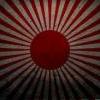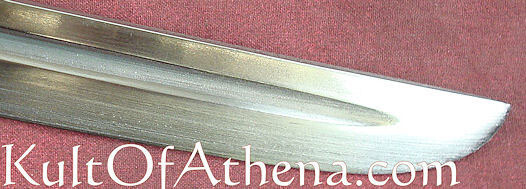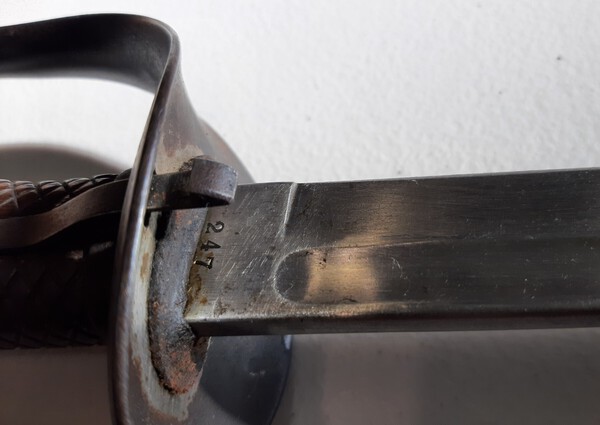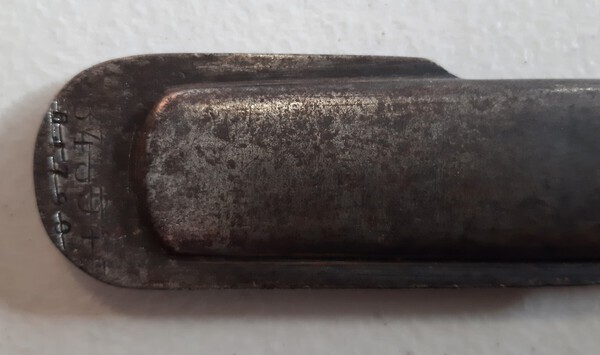-
Posts
1,402 -
Joined
-
Last visited
-
Days Won
12
Content Type
Profiles
Forums
Events
Store
Downloads
Gallery
Everything posted by Shamsy
-
That prop sword (unsurprisingly) has a very rounded tip too, Trystan. I imagine safety first. It also looks to have been 'roughed up' considerably. It's very cool to see though, thanks for sharing!
-
I'd like to amend this post. The first sword Chris posted 25/02 appears to be the Indian repro. The second Chris posts, also posted 25/02, is Polish. This is a great comparison, actually, and makes it really obvious that the Polish are just that step above the Indian examples in finer details.
-
These swords have been around for a long time, but I have yet to post a good example here, which is quite an oversight. These are not quite as good as the Polish swords, but these Indian reproductions are pretty darn close! Far, far superior to every Chinese copy. Sadly, it looks as though these are Iijima again, so there is a real mine-field with these swords now. Remember also that Iijima (IMHO) have the biggest variance in swords over their production, so always consider the whole sword and ask if in doubt. The main things that make this pop out to me are the oversized sarute, the extended and bent locking latch and the very bright and distinct tsuka screw. The bohi is also quite bad, maybe enough to stand out even amongst the great variety of bohi designs across 95s. Paint is also that not-quite-right shade, though not as dark as the Polish swords. I'll include some comments from a review on the site, since I don't have an example myself and they may be helpful: "The sword arrived with no rattles or visible damage, feels hefty and sturdy in hand with reasonable balance. Has gradual distal taper in the blade. Brass fittings are all fresh and shining. The aluminum handle feels surprisingly not that bad for what it is. Its overal shape from the first glance is rather pleasing. However, the sword tip is very ugly and do not match most of the photos of the WWII relic I could find. It resembles more of a sabre style tip without a pronounced kissaki. The shinogi line, if there was one, is flat and rounded, blended into the surface of the blade, makes it less aesthetically pleasing. Also, with a closer look, the paint on the saya was poorly applied, mine even comes with rust bubbles. What ever paint they used on the tsuka was of poor quality, and peels off easily even from just hand rubbing." Here are some photos from the only site I know that sells these (not that I go browsing for repro 95s). The site sells them for what they are, great repros. They only become 'fake' when misrepresented by another individual (usually along with an artificial patina).
-
This is what I think it looks like to me. Indian made 95 repro, very good and just slightly worse than the Polish versions. The oversized sarute, bohi, colours and tsuka screw are the parts that make it stand out.
-
Impossible to form any kind of opinion with those photos you provided. This comes back to what I've put previously in the fake thread, that you need to see a whole sword to make an informed assessment. I'll check the JC website and let you know what the whole sword looks like. Edit: Doesn't look good to me, a few too many flags on this one. I'd steer away to be on the safe side (though it is hard to tell), but if you want it for the film provenance alone (and believe that is accurate), go for it.
-

WW2 made Wakizashi - How common are they?
Shamsy replied to robinalexander's topic in Military Swords of Japan
One that I used to own is in the short gunto thread. -
The blade thickness may be reduced, yes. If you had digital callipers you could have a crack at measuring, but I find there is some different in swords anyway, presumably due to production. It'd be a long shot, but give it a go. As to distinguishing between original or reapplied numbers... I've yet to pick any great way to do so. The fonts and size absolutely change, but there is no true pattern I can see. It also doesn't help that refurbishment and restamping muddies any patterns that may exist. As you can see in my picture of the saya, they don't seem to have added any stamp (and I've not seen an example with any sort of stamp to show this, not that 32s are my field of expertise). Occasionally there is a leading zero in serial numbers, the significance of which eludes me. I don't think extra stamps are something I would expect. I imagine when a complete sword was avaliable, it was a case of send it out if there are no issues that need addressing. We've seen 95s that have been refurbished (one great example is a copper which contained a paper note in the tsuka stating as much) and yet there are no extra stamps or the like added to show this refurbishment took place. An assumption, but I'd say 32s follow suit.
-
Hamish and Bruce are correct here. Both the sword and saya numbers were removed and replaced on 32s, so don't place too much faith in an early number not being a replacement number from a factory refurbishment. I have an early number otsu which fits this category. Like Bruce, I also have an example with multiple struck numbers on the saya. I think that's a great bit of history for the sword, but the practice of replacing and re-matching saya seems to be common. The dated example Hamish is suggesting you look for refers to the stamps on the guard which can correlate to a date range. I'd go off those as a more accurate means of dating. The numbers are unreliable, though it looks like the stud for the leather loop is intact, so that at least is a good indicator of it being an earlier sword. These were discarded later and plugged. I've added a couple of pictures of two of my 32s. The first picture is my 32 with low numbers, which I believe are most likely arsenal re-stamps. The saya for that one matches, too. The second is my 32 with three serial numbers on the saya (the final is on the other side and matches the blade).
-
I thought it would be a good idea to post a few old pictures of mine where I highlighted the considerable differences between Type 95 swords. The original thread is gone and buried somewhere and this seems a natural place to re-post, since it is an educational thread intended to assist newer members of the community. Small differences may appear to a novice to be a tell-tale sign of a 'fake', but it is important to consider the sword as an overall before passing any judgement. There may be several 'issues' with a sword, but that sword will still be entirely genuine. There may be no obvious or apparent issues, but the sword may be a well made reproduction and aged into a fake. There is an overall 'feeling' to swords that I have previously mentioned which I can't really explain. It is just something that you get with experience and exposure to a large number of swords. The components of 95s were made by several subcontractors, so expect there to be differences there. Quality varies throughout production and subcontractor, so expect differences there (none more so than Iijima). Materials used in construction changed, so expect differences there. I'm sure was turn-over of workers and some degree of the process was manual, so expect differences there. Stamps changed so expect differences there (there are several distinctly different Kokura 'cannonball' stamps). Colours/shades used in paint changed, so expect differences there. Swords were refurbished, so expect changes there. My point being that there is no perfect checklist to identify a fake so you must be very aware of that before you start to label a sword, especially when it is a sale that a stray comment could derail. Sword components from various subcontractors are not universally interchangeable and it absolutely is possible to tell when a sword used mismatched components. Stegel often points this out, not just because of his extensive records, but because of his extensive experience. I can pick Polish replicas because of experience, not because of some inherent design flaw. The attached photos should be a reasonable demonstration of some of these differences. The main observations I'd like to point out are; Bohi depth, width and termination vary considerably Blade serial numbers vary considerably in font, uniformity, depth and location Quality of the cast tsuka varies considerably, as does the design Colours vary considerably Kissaki vary in size, definition and pitch We could get into greater detail, but that would result in a huge post and that is not the intent. This is also not intended to be a chastisement or to discourage attempts at authentication, but an encouragement to be thoughtful in appraisal and consider a sword as a whole, while keeping in mind the many nuances of the Type 95.
-
The groove down the blade that you are referring to is called the bohi. Or fuller. Or blood groove. I believe hi is the cutting edge. If you have a 95 you'd like to buy then post it in on the forum and we will happily give you advice around how much it would be worth, how original it is, issues etc.
-
A good example of a period, but not original, black saya.
-
Quite easy to damage the soft screws with a slip of the screwdriver. A good few 95s I have show obvious signs of the screw being removed quickly or without the proper care. Irrespective of the stamps you may find on the tang, it's nothing that changes what the sword is, so while I enjoy seeing them, better not to potentially create a rattler in the process.
-
Thanks @Bruce Pennington. One of my coppers has the same stamp, so assuming most of the double numbered coppers have the stamp.
-
Also one of less than 20 Mizuno recorded. So if you're a collector who wants one example of every known subcontractor, it's a very rare opportunity. While that might not be the driver in Japan, I'd expect these to fetch high prices elsewhere too, if the right people were competing.
-

Orginal, partialy orginal or alternative orginal
Shamsy replied to piotr67ce's topic in Military Swords of Japan
I actually just suspect that less coppers have survived. There's not a particularly long list of known examples. -

Orginal, partialy orginal or alternative orginal
Shamsy replied to piotr67ce's topic in Military Swords of Japan
What are the markings on the habaki? Pictures too low res and too high brightness to see much. -
@BANGBANGSAN I said I'd let you know if I found one that I wasn't immediately going to buy myself. Well since I have no idea how Buyee works and have never used it, here you go, courtesy of Stephen. I'd suggest, given the extreme rarity, you don't hold back on price if you want to have a full set of subcontractor stamps.
-
I can't view the auction images. Assuming the sword is the same one Vajo posted, it is indeed a Mizuno. Not sure what stamp you're referring to @Kiipu, but if it's the Mizuno subcontractor fuchi stamp, there are a fair few examples already posted on the forum and one in stamps doc (though @Bruce Pennington has it listed as maybe Mizuno when it is without doubt).
-
Two more examples of Polish Replica. Seem to be a lot of these popping up. They used to be quite rare. To me the colour is probably the most distinct thing with these, followed by bohi, sarute, stampings and the fuchi. I stand by my opinion that the sword Trystan posted is original though. To me, it looks completely different to the Polish swords.
-
I actually think that sword is genuine. The saya paint is disproportionately preserved compared with the handle, which doesn't really matter as it has signs of old wear, just not in the usual hand area (just below the suspension ring). I can't see any of the usual Polish issues. I suspect the main reason you are thinking this a repro is the bohi shape. The bohi does vary in depth and width, and the termination points, while typically a rounded scoop, can also be that narrowing 'flicked slope' look. Iijima also had the greatest variation in quality of all the subcontractors (IMHO). What I'm getting at is you need to consider the sword as a whole. To me, the patina looks good on the fittings and painted areas, colours are good, serial range is good, no issues with the sarute, fuchi stamps are good and deep on a brass coated steel, great habaki fit ... looks good to me. One last thing I'll add. There is a certain... I don't know... feeling? Intuition? When you see a lot of 95s you just kind of subconsciously pick the fakes. It's a bit weird and airy-fairy I know, but this sword looks fine to me. Happy to hear otherwise if I've missed anything.
-
Should add this sword to the Fake 95 sword thread... I'll do it at some stage today or tomorrow.
-
Looks like a Polish reproduction sword to me. The colours are very distinct. These are hard to pick though, so I'd appreciate a second opinion from @Stegel or @BANGBANGSAN
-
100% Genuine but rough condition with repainted saya, deformed handle (not uncommon and one small reason the handles became aluminium), rusty blade and maybe a replacement barrel bolt. The barrel bolt is the only real issue, but it's hard to see what is going on there. Fuchi stamps are on the other side so you can't see them. I mean, if it matched it would be okay, but not really a great example.
-
The blade looks like it has been sharpened so often there is a noticeable dip. The parts would sell, but I bet it'd be monkey who buys it to butcher. He bids on all 'parts-swords' on eBay and sells the pieces individually or makes junk swords out of them.
-
Interesting thought patterns. My first thought was to wonder if it was a Type 32 - Type 95 clone. But the answer is most likely no. Missing the signs we think a clone would show. Saya suspension ring would be a little lower, bohi (we assume) would look like the 32 (wider, round near the kissaki), the fuchi would (assumption) be stamped for Suya... much more likely the aforementioned reshaped, but I did get a little excited for a moment.


















